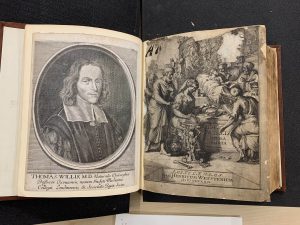 Thomas Willis (1621-1675) was a successful English physician, professor of natural sciences at Oxford, and a founding member of the Royal Society. He was an example of a physician who, instead of embracing classical authority, chose to study things based on direct observations. He was also the first to argue that research into the anatomy of the brain was the necessary foundation to speculations about the mind. Falk Library owns his work “Opera Omnia,” published in 1682 in Amsterdam by Henricus Wetstein.
Thomas Willis (1621-1675) was a successful English physician, professor of natural sciences at Oxford, and a founding member of the Royal Society. He was an example of a physician who, instead of embracing classical authority, chose to study things based on direct observations. He was also the first to argue that research into the anatomy of the brain was the necessary foundation to speculations about the mind. Falk Library owns his work “Opera Omnia,” published in 1682 in Amsterdam by Henricus Wetstein.
treasures-rare-book-room
Treasures from the Rare Book Room: Advice from a Quack or a Naturopath?
Random reflections on indigestion, bilious complaints, scrofula… by S. W. Tilke. London 1837.
This curious book is part of our gout collection, which has a few rare items. This book by Tilke, like others in the collection, is also scarce – few copies are known to be in existence. Scarce books typically were published in limited numbers, were so popular that they were read to death, or were too trivial to make it into a library collection. The scarcity of Tilke’s book may be linked to all three reasons. It was written by a self-professed expert, a baker-turned-healer, Samuel Westcott Tilke. Tilke, the owner of an establishment offering medical advice, remedies, and stay-in-clinic treatments, wrote a self-promoting work. It advertised his services, pills, medical preparations, and two products he invented: the Improved Enema Instrument and the Camphorated Spirit Bed Lamp. The language is suitable for the general public, and at one time was annotated with the handwritten notes of a studious reader. This suggests that the book gained some popularity. The presence of multiple underlined passages, marginal notes, and several additions prove that the book was studied with interest.
Treasures from the Rare Book Room: Discovering Unexpected Attributes of Old Books
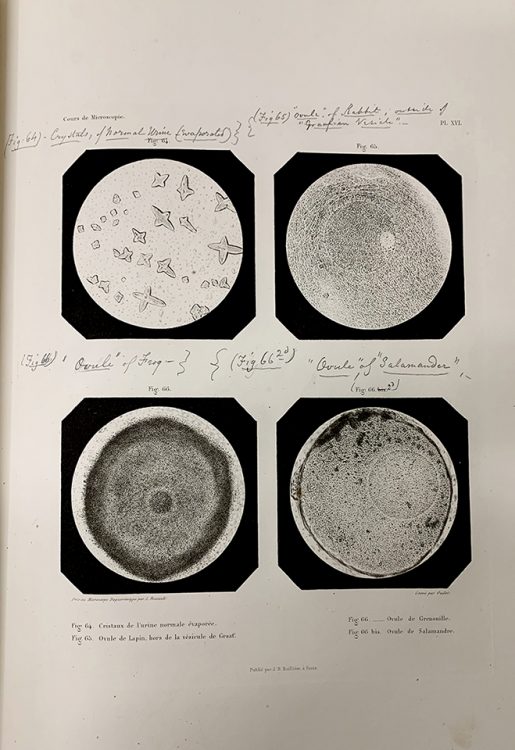 When I selected Alfred Donné’s Cours de microscopie complémentaire des études médicales, anatomie microscopique et physiologie des fluides de l’économie: atlas exécuté d’après nature au microscope-daguerréotype (Paris: J.B. Baillière, 1845) as the next feature for the Treasures from the Rare Book Room series, I was certain it would be solely about the book’s novel illustrations. It turned out that this book has a link to Abraham Lincoln!
When I selected Alfred Donné’s Cours de microscopie complémentaire des études médicales, anatomie microscopique et physiologie des fluides de l’économie: atlas exécuté d’après nature au microscope-daguerréotype (Paris: J.B. Baillière, 1845) as the next feature for the Treasures from the Rare Book Room series, I was certain it would be solely about the book’s novel illustrations. It turned out that this book has a link to Abraham Lincoln!
When this book appeared in print, the daguerreotype was cutting-edge technology. This was a new process for photographic images and was introduced to the public in 1839. However, French bacteriologist and physician Alfred Donné immediately recognized the usefulness of photography in microscopic observations. In 1840, he produced the first images under the microscope using this technique. Continue reading
Treasures from the Rare Book Room: Dr. Hitchcock’s Teeth Almanac for 1844
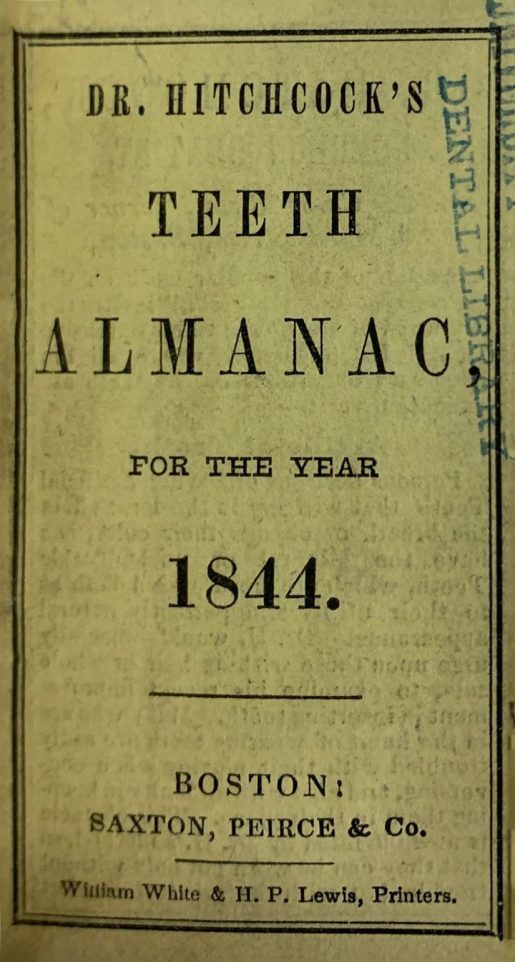 Today, the almanac is no longer the important and popular resource it once was in most households. It appeared in America at the end of the 17th century and its popularity was second only to the Bible. Almanacs offered lists of current events, advice, and weather prognostics tailored to a specific audience, such as that of the Farmer’s Almanac, and served as a basic home reference, especially for those in isolated households, helping to keep track of passing time. Dr. David Keyes Hitchcock started publishing almanacs annually around 1839, which happened years before printed calendars were invented (1870), and before there were any standards (1883)* by which to set clocks and watches.
Today, the almanac is no longer the important and popular resource it once was in most households. It appeared in America at the end of the 17th century and its popularity was second only to the Bible. Almanacs offered lists of current events, advice, and weather prognostics tailored to a specific audience, such as that of the Farmer’s Almanac, and served as a basic home reference, especially for those in isolated households, helping to keep track of passing time. Dr. David Keyes Hitchcock started publishing almanacs annually around 1839, which happened years before printed calendars were invented (1870), and before there were any standards (1883)* by which to set clocks and watches.
Dr. Hitchcock (1813-1895) was a surgeon dentist with a practice in Boston at 98 Court Street. He was the author of Preservation of the Teeth: A Family Guide, published in Boston in 1840. Falk Library has Dr. Hitchcock’s teeth almanacs for the years 1843 and 1844. The first of his dental almanacs includes standard pages with an astronomical calendar and advice on the maintenance of teeth, brushing, filling cavities, considering artificial teeth as a replacement for lost ones, and determining the right time and motives for tooth extraction. Continue reading
Treasures from the Rare Book Room: Medal of Andreas Vesalius
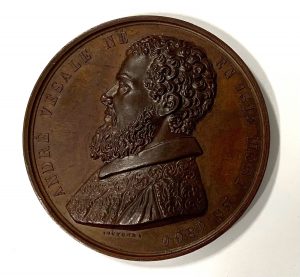 Have you ever looked at the HSLS collection of medical and scientific medals? Numismatic materials, including medals, coins, and tokens are not typical resources in a medical library. The first medals were produced in Italy in the 15th century. They were based on Roman coins, cast in bronze, and usually had portraits of emperors. The earliest medal in our collection is the Caracalla Medal. It was struck in Venice, Italy in 1466. Over the centuries, the techniques changed and new metals were used in production with later medals being cast or struck in silver or gold. By the 19th century, the medallic art became a recognizable new art form taught as a separate subject in art schools.
Have you ever looked at the HSLS collection of medical and scientific medals? Numismatic materials, including medals, coins, and tokens are not typical resources in a medical library. The first medals were produced in Italy in the 15th century. They were based on Roman coins, cast in bronze, and usually had portraits of emperors. The earliest medal in our collection is the Caracalla Medal. It was struck in Venice, Italy in 1466. Over the centuries, the techniques changed and new metals were used in production with later medals being cast or struck in silver or gold. By the 19th century, the medallic art became a recognizable new art form taught as a separate subject in art schools. 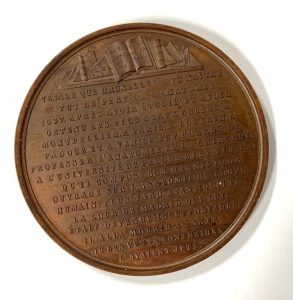 Medals, unlike coins, or at times tokens, are not monetary instruments. They are frequently used to commemorate people, events, or things. As a perfect medium, and due to their permanence, they pass along information about past events and man’s achievements to future generations.
Medals, unlike coins, or at times tokens, are not monetary instruments. They are frequently used to commemorate people, events, or things. As a perfect medium, and due to their permanence, they pass along information about past events and man’s achievements to future generations.
The Andreas Vesalius medal, slightly bigger than an American silver dollar, is a typical commemorative medal. Continue reading
Treasures from the Rare Book Room: Strong Together—Delpeuch’s History of Gout

The first edition of La goutte & le rheumatism (Paris 1900) at Falk Library is a lovely copy in a very attractive leather binding. Its author, Armand Delpeuch (1856-1901) was a physician at the Tenon and Cochin Hospital in Paris. In 1900, he published an article in La Presse Medicale, describing a new sign of aortic insufficiency, a rhythmic bobbing of the head synchronized to a heartbeat. He proposed to call it “De Musset’s sign,” after French writer Alfred de Musset, who displayed the same characteristic head-shaking. The eponym coined by Delpeuch is used to this day. He also published the history of the gout from antiquity to the end of the 17th century. It was the authoritative source on the history of this disease for more than half a century.
Delpeuch’s book is not very old or rare, nor is it a unique copy. What is so special about it then? It is valuable because of the context in which this book exists. It is a part of our Rodnan Collection. Continue reading
Treasures from the Rare Book Room: Erik H. Erikson’s Manuscript

Historical manuscripts hand-copied by scribes largely disappeared after the invention of the printing press. With the advent of typewriters and computers, modern handwritten texts are also scarce and soon might disappear altogether. Today’s text editors do not offer the same opportunity to study penmanship, deletions, and notations to glimpse a writer’s personality and writing process. Falk Library’s small manuscript collection aims to preserve some handwritten resources to give researchers another angle from which to study the past.
Erik Homberger Erikson (1902-1994), a German-American developmental psychologist and psychoanalyst, is famous for his theory of the stages of psychosocial development, and for coining the term “identity crisis.” He never received a formal degree in medicine, but instead studied art, traveled widely in Europe in order to “find himself,” and studied psychoanalysis with Anna Freud in Vienna. He moved to the United States in 1933 and began working as a child psychoanalyst. He held various teaching positions at Harvard, Yale, and Berkeley. While working at the Austen Riggs Center in the 1950s, he was also a visiting professor at the University of Pittsburgh. Continue reading
Treasures from the Rare Book Room: The Curious Life of the Medical Battery
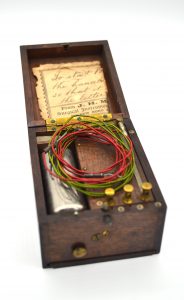
Physicians recognized the therapeutic use of electricity as early as the 1st century AD, centuries before the invention of modern electrotherapeutic devices. Scribonus Largus, the court physician to Roman Emperor Claudius, developed an interesting prescription for gout and headache. The advice was to stand on a torpedo fish, which was thought to deliver a strong electric discharge. The 18th century brought further developments by Luigi Galvani, the discoverer of animal electricity, and Alessandro Volta, inventor of the early electric battery.
Batteries used in electrotherapy evolved dramatically in the 19th century. Early ones used chemical reaction to produce electricity. Wet cells used in these batteries were prone to leakage. The invention of dry cells, in which paste replaced electrolytes, made them more portable. Batteries could provide direct current (galvanic), alternating current (faradic) or both. The variety of available devices made possible the advancement of electrotherapeutics. The widest use of medical batteries occurred between 1870 and 1920. These were considered to be a legitimate medical tool to provide electrical treatments both at home and in the clinic. Medical batteries fell out of favor in the 20th century. Today, when they appear on the antique markets or eBay, they are dubbed as “quack medical devices.” Why is that?
Treasures from the Rare Book Room: Charles Estienne’s Anatomy Book
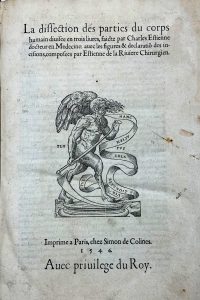 Charles Estienne (1504-1564) was a contemporary of Andreas Vesalius. He came from a family of Parisian printers and publishers. Estienne studied classical philology at the University of Padua in Italy, and upon his return to France, earned a medical degree at the University of Paris. He practiced medicine and taught anatomy at the Faculté de Médicine (1544-1547). His De dissectione partium corporis humani (1545) is often compared to the famous De humani corporis fabrica by Vesalius (1543). Estienne prepared anatomical drawings with the surgeon and artist Etienne de la Riviére. They partially printed the book in 1541, but its full publication was delayed due to a lawsuit in which both collaborators were involved. Had it appeared as planned, this work may have changed several “firsts” in medical history as claimed by Vesalius. Continue reading
Charles Estienne (1504-1564) was a contemporary of Andreas Vesalius. He came from a family of Parisian printers and publishers. Estienne studied classical philology at the University of Padua in Italy, and upon his return to France, earned a medical degree at the University of Paris. He practiced medicine and taught anatomy at the Faculté de Médicine (1544-1547). His De dissectione partium corporis humani (1545) is often compared to the famous De humani corporis fabrica by Vesalius (1543). Estienne prepared anatomical drawings with the surgeon and artist Etienne de la Riviére. They partially printed the book in 1541, but its full publication was delayed due to a lawsuit in which both collaborators were involved. Had it appeared as planned, this work may have changed several “firsts” in medical history as claimed by Vesalius. Continue reading
Treasures from the Rare Book Room: The Super Brief History of Bloodletting
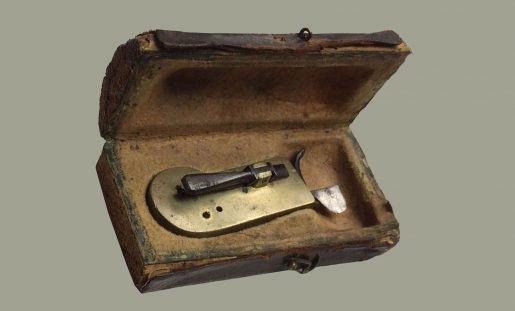
Bloodletting is thousands of years old. The therapy was based on Hippocrates’s humours theory. Though controversial from the beginning, it was widely in use by the second century AD. Galen was an avid enthusiast of the therapy. Bloodletting achieved the height of popularity in the 17th and 18th centuries. Its wide acceptance waned in the 19th century, and at the turn of 20th century, was completely rejected as quackery. Bloodletting was often abused as a therapeutic technique for curing every illness. The recent discovery that therapeutic bleeding can be an effective treatment in selected conditions caused by iron overload, has led to the re-evaluation of bloodletting. A technique that was once seen as barbaric and ignorant, now has been revived in some instances.
Treasures from the Rare Book Room: When the Provenance Matters
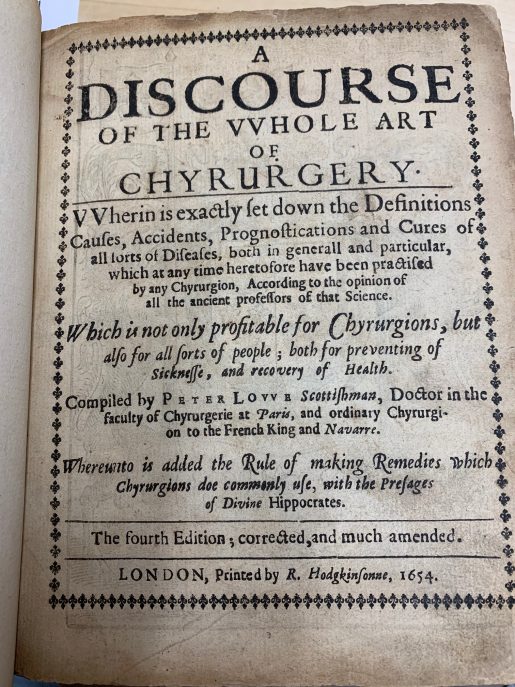 Peter Lowe, author of A Discourse of the Whole Art of Chirurgery published in London in 1654, left a significant mark on Scottish medicine by founding the Faculty of Physicians and Surgeons in Glasgow, reorganizing the practice of medicine in the same city, and then writing a book that made quite a stir. Contrary to the dominating trend at that time to write scientific books in Latin, this book was written in the vernacular and enjoyed great popularity (four editions in the 17th century). However, even more than its importance to 17th century medicine, are the provenance notes added in the 19th century that make the volume in Falk Library’s rare book collection special and unique.
Peter Lowe, author of A Discourse of the Whole Art of Chirurgery published in London in 1654, left a significant mark on Scottish medicine by founding the Faculty of Physicians and Surgeons in Glasgow, reorganizing the practice of medicine in the same city, and then writing a book that made quite a stir. Contrary to the dominating trend at that time to write scientific books in Latin, this book was written in the vernacular and enjoyed great popularity (four editions in the 17th century). However, even more than its importance to 17th century medicine, are the provenance notes added in the 19th century that make the volume in Falk Library’s rare book collection special and unique.
Three prominent 19th century physicians, Sir John Eric Erichsen, Marcus Beck, and Herbert Seager, owned this book in succession. Continue reading
Treasures from the Rare Book Room: Humphrey Ridley Remembered
Humphrey Ridley (1653-1708) was a little-known English neuroanatomist who studied medicine at Merton College in Oxford, and received his medical degree from Leyden University in 1679. Upon his return to England, he was a physician at Cambridge University and a member of Royal College of Physicians. There is not much known of his personal life, and he left only three published works: first on the topic of venereal diseases (1679), next on anatomy of the brain (1695), and the third on asthma (1703).
His book, Anatomy of the Brain Containing Its Mechanism and Physiology, followed two earlier and more commonly cited works in neurology, one by Thomas Willis and the other by Raymond Vieussens, but Ridley’s was the first neuroanatomy treatise in the English language. He acknowledged the brilliance of his predecessors, but also corrected some of their mistakes and omissions. He was the first to describe the ophthalmic artery and the ganglion of the fifth cranial nerve. According to Thakur, et al., Ridley was also the first to describe arachnoid cisterns and the arachnoid membrane, but because his contributions were not previously mentioned, Bichat and Ruysch held this claim even though their works were published later. Thakur and his colleagues speculated that Ridley’s stationary life and lack of clinical legacy might have contributed to the sad fact that his mastery in cadaveric injections and his novel contributions have gone unnoticed and uncited for so long.
Treasures from the Rare Book Room: Ludovic Hirschfeld–A Sedulous Anatomist
The career of Ludovic Hirschfeld was a rags to riches story. Ludwik Maurycy Hirschfeld, as he was known in Poland, was born into a poor Jewish family around 1814. His father worked as a ritual butcher in Warsaw. Helping his father, the young boy discovered his interest in anatomy. He delved into medical books, but also pursued studies in music to hide his true dream of becoming a physician. After an unsuccessful attempt to enter medical school in Wroclaw, he left Poland and walked to Paris to pursue this goal. Initially, he supported himself by playing violin and working as a janitor in an anatomy laboratory at the École Pratique de Médicine, but soon found work in the laboratory of the famous anatomist, Professor Jean-Baptiste Marc Bourgery, who quickly came to appreciate his skills in specimen preparations. He promoted Hirschfeld to be his main assistant for dissections. Later, with Bourgery’s help, Hirschfeld began assisting Professor Mathieu Orfila with autopsies. Orfila also quickly noted Hirschfeld’s aptitude, and as the dean of the medical school, helped him enroll in the program. Hirschfeld graduated with a medical degree in 1848, and remained in Paris for the next 10 years. In 1859, he accepted a position at the Medical and Surgical Academy in Warsaw (predecessor of the Warsaw University) where he practiced medicine and taught anatomy until his retirement in 1875. Continue reading
Treasures from the Rare Book Room: Early Medical Depictions of Hospitalized “Hysterics and Epileptics”
October was Mental Health Awareness Month at Pitt. The Student Government Board organized multiple activities to raise awareness and send a clear message to those struggling with depression and/or anxiety that “you are not alone.” Looking at the history of mental illness, it is obvious that this caring attitude was frequently not the norm in the past.
One book from our collection that demonstrates this observation is Iconographie Photographique de la Salpêtrière published in Paris in 1877. It is a gem of medical photography, and was created by Désiré-Magloire Bourneville and Paul Regnard, disciples of Jean Martin Charcot.